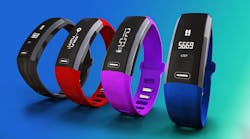Traditionally, small chip antennas used in Bluetooth-enabled devices have required a designated ground “keep out” area to minimize interference from other components and ensure the ideal radiation pattern for wireless signals. In some cases, this reserved space can eat up as much as 15 × 20 mm of the printed circuit board (PCB).
However, with the drive to further miniaturize connected “smart” wearables for fitness and activity tracking, new tiny embedded chip antennas are now available that mount directly above metal surfaces to save as much as 10% to 20% of board space. This has major implications for manufacturers of smart rings, bracelets, shoes, jeans, shirts, and other apparel since the PCB, along with its coin-cell batteries, typically dictate the minimum size of the electronics involved.
Smart Wearables
A wave of “smart” wearable devices has already entered the market to monitor everything from fitness and health to the physical environment. Often equipped with gyroscope, accelerometer, temperature and pressure sensors, along with GPS and even microphones, these tiny devices can track vital signs, sleep, emotions, stress, breathing, movement, and send/receive messages and alerts through text, audible sounds, and even colors. As with any “connected” device, this information is then shared via wireless signals such as Bluetooth to a smartphone.
Among the products already incorporating this type of technology are smart bracelets that monitor movement, body position, and vital signs to detect if an elderly person has had a debilitating fall; a necklace that records voice memos before translating them into text; and even 8k gold-plated rings with choice of gemstone that serve as activity trackers.
Connected clothing and other apparel, such as jeans, yoga pants, and other attire, also now contain sensors designed to keep track of workouts and monitor body temperature, posture, and movement. Not to be outdone, the $130.3 billion retail sports footwear market offers intelligent running shoes that connect to popular distance/speed tracking apps while also measuring acceleration, cadence, ground contact time, and other factors to improve performance.
Embedded Chip Antennas
To make this all work, each device must contain small RF chip antennas embedded on the PCB or behind the scenes underneath the encasement of the product. These chip antennas radiate and receive electromagnetic (EM) waves much like other types of antennas, but the most notable difference is their small size. In fact, today’s mobile phones incorporate a minimum of four antennas and up to 13 in some models. Smaller wearable devices may only contain one or two antennas.
To work properly, chip antennas usually depend on a ground plane, meaning they require an appropriately sized and positioned ground plane to form a complete resonant circuit. While the PCB can serve as the ground plane, the antenna itself must typically be placed on the edge of the board in an isolated section free from ground and metal components that would otherwise distort its radiation. Without the isolation distance, the performance of the antenna is significantly affected.
“The ‘keep-out area’ is fundamental to ensure the chip antenna can electromagnetically radiate to antenna applications, because everything affects the radiation pattern, including the package size, where the antenna is mounted, and its proximity to the human body,” says Manuel Carmona of Johanson Technology, a leader in high-frequency ceramic components, including chip antennas, high-Q capacitors, and EMI chip filters.
According to Carmona, Johanson Technology has been able to eliminate the requirement for a designated ground keep-out area by optimizing materials (ceramics and inks), manufacturing processes, and RF circuit design.
The company has developed a 2.4-GHz antenna that can be mounted directly onto the metal ground plane. Measuring 2 × 5 mm, it’s designed for small coin-cell-battery-operated wearable applications where metal or a battery/display covers the entire length or side of the PCB.
“With PCB real estate at a prime, the size and placement of the chip antenna is critical because as everything gets smaller, it becomes increasingly difficult to place more components on the board,” explains Carmona. “Therefore, design engineers are looking to component manufacturers to deliver miniaturized solutions that occupy next to no real board space.”
The design of the antenna itself is also critical to its range and performance. With smart wearables, radio interference or some other glitch could result in interrupted connectivity.
There can be legal ramifications as well. As with any wireless device, products that utilize RF technology, including Bluetooth, to collect or transmit information are subject to regulation by the Federal Communications Commission (FCC). Therefore, it’s essential that the device perform at the designated frequency, and the design and placement of the antenna is critical to proper tuning.
Despite the critical nature of the antenna, Carmona says it’s often overlooked until late in the design process, at which point optimal antenna performance may not be achievable within the space provided. To assist with chip antenna design and selection, Johanson Technology offers a program in which design engineers can send in a miniaturized device and the company will tune the antenna for optimum functionality.
“A chip antenna that can be mounted over a ground plane opens up many applications for products that want to incorporate wireless,” says Carmona. “To date, we have received everything from smart shirt buttons to jewelry and other wearables in various shapes and sizes.”
For more information, contact Johanson Technology at (805) 389-1166, e-mail [email protected], or visit www.johansontechnology.com/ant. The company is located at 4001 Calle Tecate, Camarillo, CA 93012.
Jeff Elliott is a Torrance, Calif.-based technical writer. He has researched and written about industrial technologies and issues for the past 20 years.



